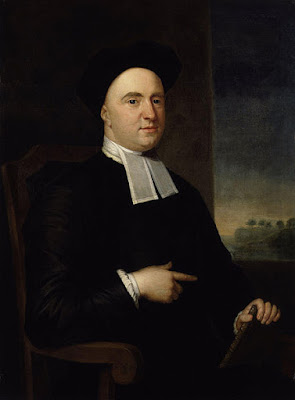About George Berkeley
 |
| George Berkeley, 1685 - 1753 Painting by John Smibert (d. 1751) _________________________________ |
George Berkeley—12
March 1685 – 14 January 1753) – known as “Bishop Berkeley” (Bishop
of Cloyne) – was an Irish philosopher whose primary achievement was the
advancement of a theory he called “immaterialism” (later referred to as “subjective idealism” by others).
This theory denies the existence of “material substance”
and instead contends that familiar objects like tables and chairs are only “ideas”
in the minds of “perceivers” and, as a result, cannot exist without
being perceived. Berkeley is also known for his critique of abstraction,
an important premise in his argument for immaterialism.
Berkeley was the namesake of the city of Berkeley, California, which is most famous
as the home of the University of California, Berkeley.
Berkeley College, one of
Yale University’s 14 residential colleges, is named after George Berkeley.
In 1709, Berkeley published his first major work, An Essay towards a New Theory
of Vision, in which he discussed the limitations of human vision and
advanced the theory that the proper objects of sight are not material objects,
but light and color. This foreshadowed his chief philosophical work, A Treatise
Concerning the Principles of Human Knowledge, in 1710, which, after its
poor reception, he rewrote in dialogue form and published under the title Three Dialogues between
Hylas and Philonous in 1713.
In this book, Berkeley’s views were represented by Philonous (Greek: “lover
of mind”), while Hylas (Greek: “matter”) embodies the Irish thinker’s
opponents, in particular John Locke.
Berkeley argued against Isaac
Newton’s doctrine of absolute space, time and motion
in De Motu (“On Motion”), published
1721. His arguments were a precursor to the views of Mach
and Einstein.
In 1732, he published Alciphron,
a Christian apologetic against the free-thinkers,
and in 1734, he published The Analyst, a critique of the foundations of calculus,
which was influential in the development of mathematics.
His last major philosophical work, “Siris” (1744), begins by advocating
the medicinal use of tar water and then continues to discuss a wide range
of topics, including science, philosophy, and theology. Interest in Berkeley’s
work increased after World War II because he tackled many of the issues of
paramount interest to philosophy in the 20th century, such as the problems of
perception, the difference between primary and secondary qualities, and the
importance of language.